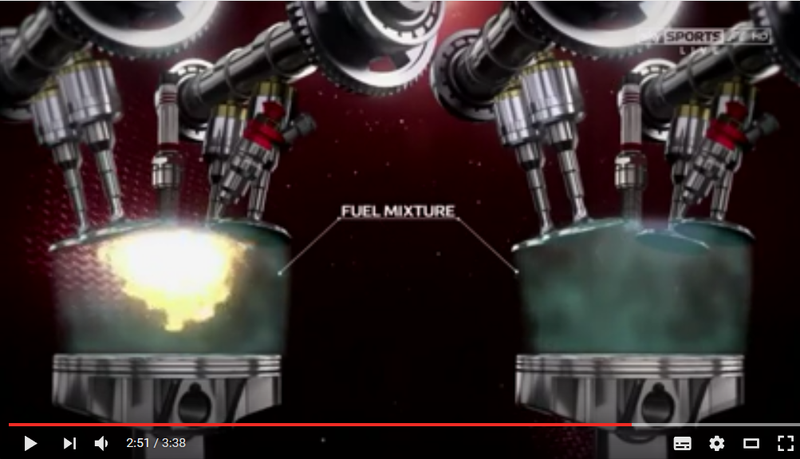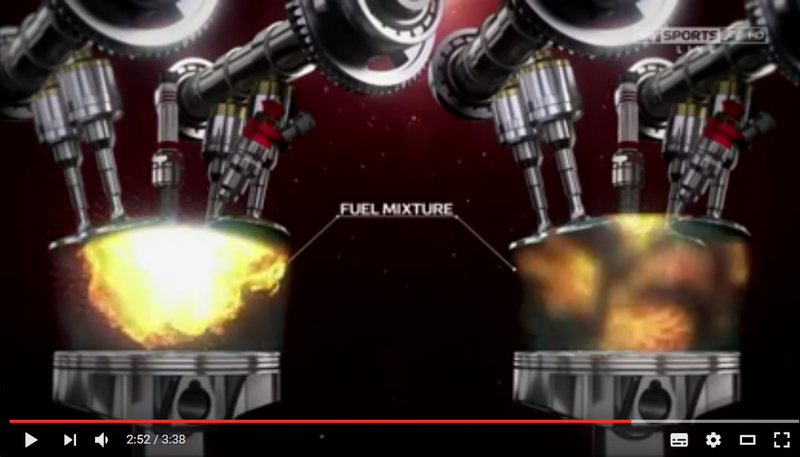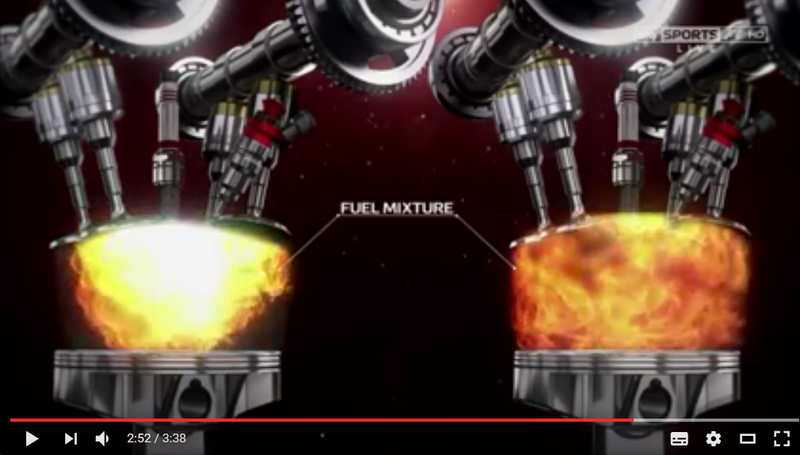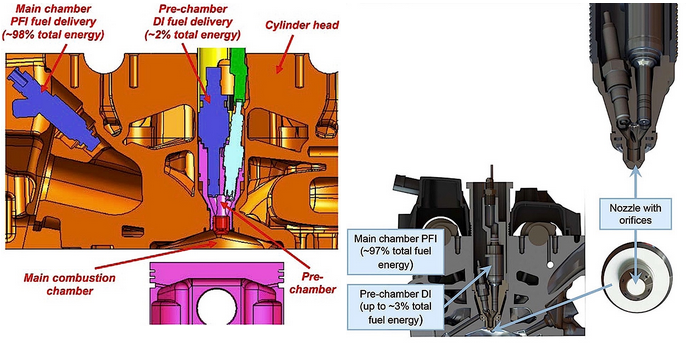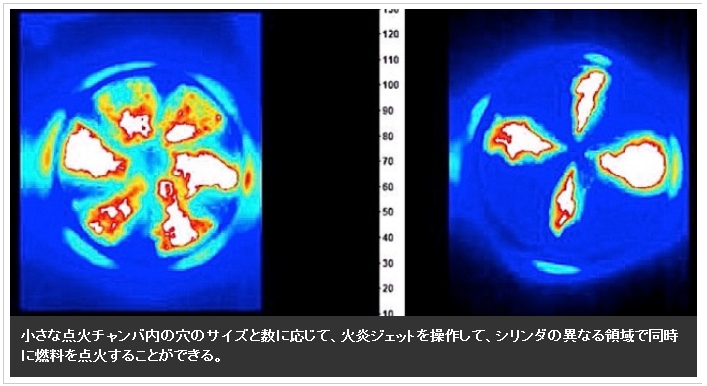「嫌なものは見たくない」という典型的な日本人的思考のヘタレ親父は、ホンダが活躍しないF1など見たくないと目を逸らせてきました。これは日本中が同様のようで「タービュレント・ジェット・イグニッション」でググっても解説記事など出てきません。
ところが Turbulent Jet Ignition で検索すればザックザックとヒットし、何だか日本(日本語)だけが蚊帳の外、情報鎖国状態のような寂しさを感じます。
なお、この技術は「
マーレ社のホームページを見ると元々これは一般エンジン用でマーレ社のアピールする長所は高効率、低燃費、低NOXです。
F1に目を向けると最初に目を付けたのはコスワース社で、そのあとメルセデスが採用したようですが、現在のF1はハイブリッドを採用しており、燃料総量・流量が制限されており、出力と燃費のバーターのような面もありますので、高効率高出力が要求され、ルノーはこれを採用して30馬力アップしたといいます。
なお、ここに紹介するTJIの図は一般エンジン用で燃料噴射ノズルが2つありますが、F1の規則では噴射ノズルは一つのみですので、構造が違います。
とりあえず前回の記事の動画を見てみます。(2分50秒から)
右側の混合器は、一番上の図ではまだ点火していないにも関わらず、二番目、三番眼の図では一気に全体に均質に燃焼が広がり、しかも左側よりも燃焼温度が低いように見えます。
これはNOXが少なく、熱効率が良く、CO2排出量が少ない事が期待できそうな気がします。
※マーレ社は「The Development of a Pre-Chamber Combustion System for Lean Combustion of Li quid and Gaseous Fuels」を見るとOptical Engineでテストしています。
■解説については「F1Tech-What is Turbulent Jet Ignition」などを見ると良いと思います。
以下に引用させていただきます。
参考までにグーグル翻訳も併記します。
大分面白い翻訳になっていますが、我慢して下さい![]() 。
。
Improving combustion efficiency is key for F1 engineers since the regulations limit the total amount of fuel that can be used in a race as well as the fuel-flow rate.
F1の技術者にとっては、レースで使用できる燃料の総量と燃料流量を規制するため、燃焼効率を向上させることが重要です。
This new technology replaces the standard spark plug in each cylinder with a jet ignition chamber and helps support ultra lean-burn operation in gas engines. If properly designed, this jet igniter can be a drop-in replacement for the spark plug.
この新技術は、各シリンダーの標準点火プラグをジェット点火チャンバーに置き換え、ガスエンジンの超希薄燃焼運転をサポートするのに役立ちます。 適切に設計されていれば、このジェット点火装置は、点火プラグの代わりに使用することができる。
It’s basically the most advanced evolution of ignition since the basic spark plug was invented over a century ago. There have been plenty of alternative spark technologies proposed over the past few decades by engineers, including using microwave, plasma and even lasers to ignite the air-fuel mixture in an internal combustion engine (ICE). But Formula 1 doesn’t allow any type of high-frequency ignition, and automakers have yet to find an alternative that’s as cost-effective as the traditional spark plug.
基本的なスパークプラグは1世紀以上前に発明されて以来、基本的に最も高度なイグニッションの進化です。 過去数十年にわたって、内燃機関(ICE)内の空気 - 燃料混合物を点火するためにマイクロ波、プラズマ、さらにはレーザーを使用することを含む、多くの代替スパーク技術が技術者によって提案されてきた。 しかし、F1はどんなタイプの高周波点火も可能とせず、自動車メーカーは従来の点火プラグほど費用対効果に優れた代替品を見つけることはまだありません。
At first, observers surmised that F1 engine builders had solved all the mysteries and problems of homogeneous charge compression igntion (HCCI), or at least were using a form of HCCI along with spark ignition. HCCI is somewhat the holy grail of combustion for an ICE, since it theoretically leverages the best benefits of both spark and compression engines. In its simplest form, an HCCI engine draws an air-fuel mixture into the cylinder, similar to a gas spark engine, then then ignites the mixture using compression, similar to a diesel engine.
最初に、F1エンジン製造者が、均一充填圧縮永久歪 均質予混合圧縮着火 (HCCI)の謎と問題をすべて解決したか、少なくとも火花点火とともにHCCIの形態を使用していたと観測者は推測した。 HCCIは理論的には、スパークエンジンと圧縮エンジンの両方の利点を最大限に活用しているため、ICEの燃焼の聖杯です。 その最も単純な形態では、HCCIエンジンは、ガス燃料スパークエンジンと同様に、気筒内に空気 - 燃料混合物を吸入し、次いで、ディーゼルエンジンと同様に圧縮を用いて混合物を点火する。
There is no spark or fuel-delivery timing, but there’s a much lower temperature combustion. That means lower NOx emissions and higher heat efficiency, which cuts down on CO2 emissions. The only problem is that there are no timing controls. Ignition is solely at the mercy of the laws of chemistry and physics, so high-speed and high-load conditions where cylinder temperatures rise can be a quite unpredictable.
火花や燃料供給のタイミングはありませんが、温度の燃焼 燃焼温度ははるかに低温です。 これは、NOx排出量を減らし、熱効率を高め、CO2排出量を削減することを意味します。 唯一の問題は、タイミングコントロールがないことです。 点火は化学と物理の法則の慈悲でしかないので、シリンダーの温度が上昇する高速で高負荷の状態はまったく予測できません。
You can see why a frenzy spread through the F1 discussion groups and media. But most recently it was revealed that TJI was the technology in question. When the secret spread to Ferrari, the Italians had a great partner in Mahle, an aftermarket supplier that has been touting the benefits of TJI since the turn of the decade.
F1のディスカッション・グループやメディアを通して、なぜ熱狂が広がったのかが分かります。 しかし、最近ではTJIが問題の技術であることが明らかになりました。 秘密がフェラーリに広がったとき、イタリア人は、10年ぶりにTJIのメリットを宣伝してきたアフターマーケットのサプライヤであるMahleに大きなパートナーを持っていました。
As mentioned earlier, TJI replaces the spark plug with a jet ignition chamber. During the compression stroke, around 97 percent of the fuel charge is injected directly into the cylinder and the remaining three percent of fuel is directed into the chamber where a traditional spark plug ignites that small, overly rich charge within the tiny confines of the chamber. The resulting high-pressure jet stream of hot gasses are forced through a number of tiny holes in the chamber and into the main cylinder to ignite the rest of the air-fuel charge, which is by now thoroughly mixed and lean. According to Mahle, these hot jets fire out to the edge of the piston to ignite the mixture.
先に述べたように、TJIは、点火プラグをジェット点火チャンバーに置き換えます。 圧縮ストローク中、燃料充填物の約97%がシリンダーに直接噴射され、残りの3%の燃料がチャンバー内に導かれ、伝統的なスパークプラグがチャンバーの狭い範囲内の小さすぎる過剰なチャージを発火させる。 得られた高温ガスの高圧ジェット流は、チャンバ内の多数の小さな穴を通ってメインシリンダー内に押し込まれ、空気燃料の残りの部分を点火する。これは今や完全に混合され、傾けられている。 Mahleによると、これらのホットジェットはピストンの端まで発火して混合物を点火する。
From a Mahle annual report: “While ignition normally takes place in the center of the cylinder, with Mahle Jet Ignition it essentially takes place from the outside toward the inside. This allows significantly better combustion of the fuel mixture. The result: more power with considerably less residue.”
Mahleの年次報告書から:「点火は通常、シリンダーの中心で行われ、Mahle Jet点火では、それは本質的に外側から内側に向かって行われます。 これにより、燃料混合物の著しく良好な燃焼が可能になる。 その結果、残渣がかなり少なく、より多くの電力 出力が得られます。
When word of TJI first broke, many publications used illustrations from early Mahle reports and presentations, but the equipment depicted was for a production engine that utilized two injectors per cylinder: one for the main air-fuel charge and a secondary injector just for the ignition chamber. However, Formula 1 allows only a single injector per cylinder, so team engineers had to design a unique combustion chamber with a pre-ignition chamber that supports the spark plug, yet can still draw that 3 percent of fuel from the injector. The final effect is still the same with flame jets coming out of the small chamber and igniting the compressed air-fuel mixture at several points simultaneously in the cylinder.
TJIの言葉が最初に壊れたとき、多くの出版物はMahleの初期の報告とプレゼンテーションからのイラストを使用しましたが、描かれている装置はシリンダー当たり2つのインジェクターを使用する生産エンジン用でした。主な空気燃料の充填と点火のための2次インジェクターチャンバー。 しかし、式1 F1では、1つのシリンダーにつき1つのインジェクターしか使用できないため、チームエンジニアは、点火プラグを支持するプレイグニッションチャンバーを備えた独自の燃焼チャンバーを設計する必要がありました。 最終的な効果は、小さなチェンバーから出てくる炎ジェットが、シリンダー内のいくつかの点で圧縮空気 - 燃料混合物を同時に点火することと同じである。
ワタシの若いころはDOHCエンジンさえ高価なスポーツモデルのみ、DOHC4バルブに至ってはスカイラインGTRとフェアレディZ432のみで、超高値高嶺の花でした。それが今では大衆車でさえDOHC4バルブが当たり前になっています。
そのうちにTJIが当たり前の時代が来るかも知れませんが、もっと海外の情報がどんどん入ってきて欲しいと思います。
